Hyundai Elantra: Cylinder Head Assembly / CVVT & Camshaft Repair procedures
| • |
Use fender covers to avoid damaging painted surfaces. |
| • |
To avoid damage, unplug the wiring connectors carefully while holding the connector portion. |
|
| • |
Mark all wiring and hoses to avoid misconnection. |
| • |
Turn the crankshaft pulley so that the No. 1 piston is at top dead center. |
|
Timing chain cover removal is not required for this procedure.
| 1. |
Remove the cylinder head cover.
(Refer to Cylinder Head Assembly - “Cylinder Head Cover”) |
| 2. |
Remove the intermediate lock CVVT actuator (A). 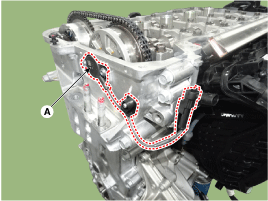
|
| 3. |
Set No.1 cylinder to TDC (Top dead center) on compression stroke.
| (1) |
Turn the crankshaft pulley and align its groove with the timing mark of the timing chain cover. 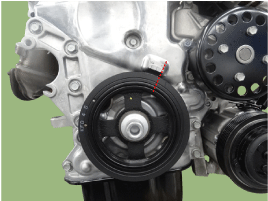
|
| (2) |
Check that the TDC marks of the intake and exhaust CVVT
sprockets are in straight line on the cylinder head surface as shown in
the illustration. If not, turn the crankshaft by one revolution (360°)
more. 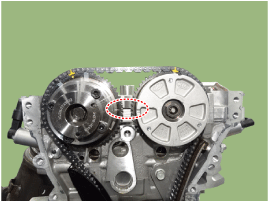
|
| (3) |
Mark the timing chains corresponding to the timing marks of the CVVT sprockets. 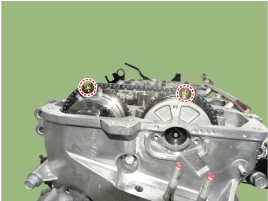
|
|
| 4. |
Remove the crankshaft damper pulley.
(Refer to Timing System - “Crankshaft Damper Pulley”) |
| 5. |
Remove the service plug bolt (A) with the gasket (B). 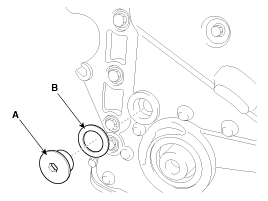
|
| 6. |
Remove the tensioner arm bolt (A). 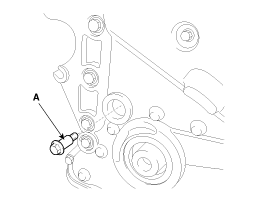
|
| 7. |
Push down the tensioner arm (A). 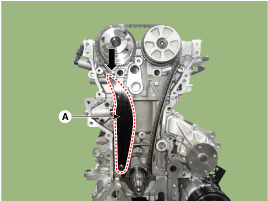
|
| 8. |
Remove the camshaft bearing caps. 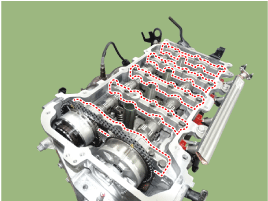
|
| 9. |
Remove the exhaust camshaft (A) first, then intake camshaft (B). 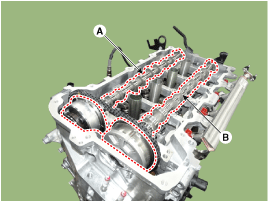
|
| 10. |
Remove the tensioner arm (A). 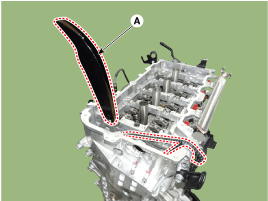
| • |
To hold the timing chain, tie it with strap. |
|
|
| 11. |
Remove the CVVT assembly (A) from the camshaft. 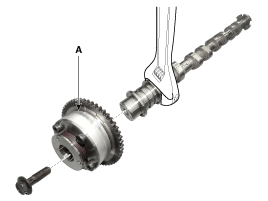
| • |
When removing the CVVT assembly bolt, hold the camshaft with a wrench to prevent the camshaft from rotating. |
|
|
Camshaft
| 1. |
Inspect the cam lobes.
Using a micrometer, measure the cam lobe height.
If the cam lobe height is less than specification, replace the camshaft.
Cam height
Intake: 39.0 mm (1.5354 in.)
Exhaust: 39.0 mm (1.5354 in.)
|
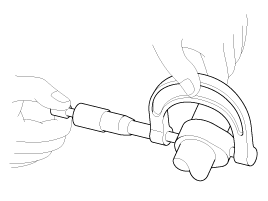
|
| 2. |
Check the surface of the camshaft journal for wear.
If the journal is worn excessively, replace the camshaft. |
| 3. |
Inspect the camshaft journal clearance.
| (1) |
Clean the bearing caps and camshaft journals. |
| (2) |
Place the camshafts on the cylinder head. |
| (3) |
Lay a strip of plastigage across each of the camshaft journal. 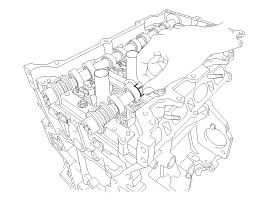
|
| (4) |
Install the bearing caps and tighten the bolts with specified torque.
Tightening torque
M6 bolts:
11.8 ~ 13.7 N.m (1.2 ~ 1.4 kgf.m, 8.7 ~ 10.1 lb-ft)
M8 bolts:
18.6 ~ 22.6 N.m (1.9 ~ 2.3 kgf.m, 13.7 ~ 16.6 lb-ft)
|
| • |
Do not turn the camshaft. |
|
|
| (5) |
Remove the bearing caps. |
| (6) |
Measure the plastigage at its widest point.
If the oil clearance is greater than specification, replace
the camshaft. If necessary, replace the bearing caps and cylinder head
as a set.
Bearing oil clearance
Standard:
0.032 ~ 0.062 mm (0.00126 ~ 0.00244 in.)
|
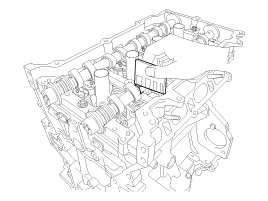
|
|
| 4. |
Inspect the camshaft end play.
| (1) |
Install the camshaft bearing caps. |
| (2) |
Using a dial indicator, measure the end play while moving the camshaft back and forth.
If the end play is greater than specification, replace the camshaft.
If necessary, replace the bearing caps and cylinder head as a set
Camshaft end play
Standard:
0.10 ~ 0.19 mm (0.0039 ~ 0.0075 in.)
|
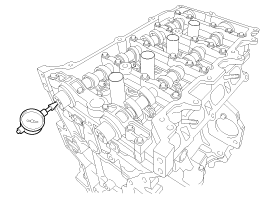
|
| (3) |
Remove the camshafts. |
|
Continuously variable valve timing (CVVT) Assembly
| 1. |
Inspect the CVVT for smooth rotation.
| (1) |
Clamp the camshaft using a vise. Be careful not to damage the cam lobes and journals in the vise. |
| (2) |
Check that the CVVT is locked by turning it clockwise or counterclockwise. It must not rotate. |
| (3) |
Intake CVVT : Seal one of the two advance holes in the camshaft journal with tape.
Exhaust CVVT : Seal one of the two retard holes in the camshaft journal with tape. 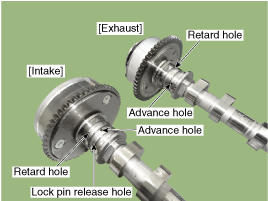
|
| (4) |
Intake CVVT :
| (1) |
press the center of the valve bolt (A). |
| (2) |
Apply approx. 50 kPa (0.5 kgf /cm?, 7 psi ) of compressed air into the lock pin release hole to release the lock. 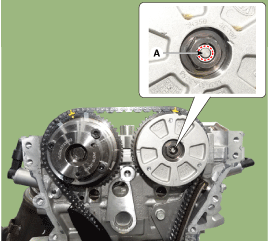
Exhaust CVVT : Apply approx. 150 kPa (1.5 kgf /cm? 21 psi ) of compressed air into the unsealed retard hole to release the lock. |
| • |
Cover the oil paths with a piece of cloth when applying compressed air to prevent oil from spraying. |
|
|
| (5) |
Intake CVVT : With compressed air applied, rotate the CVVT
into the advance direction (counterclockwise) within its phasing range
and check that the CVVT turns smoothly.
Exhaust CVVT : With compressed air applied, rotate the CVVT
into the retard direction (clockwise) and check that the CVVT turns
smoothly.
CVVT phasing range
Intake : 40° (20° advance and 20° retard from the initial position)
Exhaust : 20°±1° (from the most advanced position to the most retarded position)
|
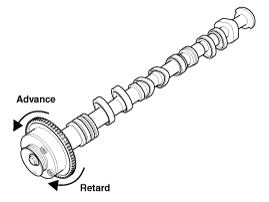
|
| (6) |
Intake CVVT :
| A. |
Move to the center to check that lock pin closes well. |
| B. |
Rotate the CVVT into the most retarded position (clockwise) and then check that the CVVT is locked. |
Exhaust CVVT :
| A. |
Rotate the CVVT into the most advanced position (counterclockwise) and then check that the CVVT is locked. |
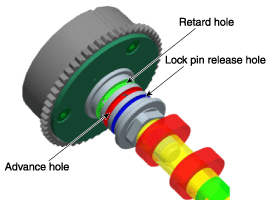
|
|
| 1. |
Install the CVVT assembly (A) to the camshaft.
Tightening torque :
64.7 ~ 76.5 N.m (6.6 ~ 7.8 kgf.m, 47.7 ~ 56.4 lb-ft)
|

| • |
When installing the CVVT assembly bolt, hold the camshaft with a wrench to prevent the camshaft from rotating. |
|
|
| 2. |
Compress the piston of the tensioner using a handy bar (A)
and then insert a stopper pin (B) into the hole on the tensioner to hold
the compressed piston. 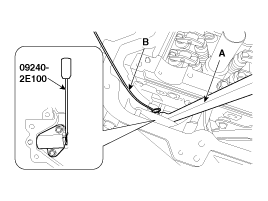
|
| 3. |
Place the intake camshaft (A) and then insert the tensioner arm (B) along the timing chain. 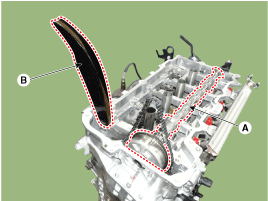
|
| 4. |
Place the exhaust camshaft (A). 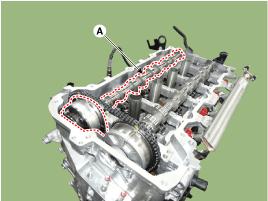
| • |
The timing marks of each CVVT sprocket should be matched with
timing marks (painted link) of timing chain when installing the timing
chain. |

|
|
| 5. |
Install the camshaft bearing caps. 
Tighten the bolts, in several passes, in the sequence as shown.
Tightening torque
M6 bolts:
11.8 ~ 13.7 N.m (1.2 ~ 1.4 kgf.m, 8.7 ~ 10.1 lb-ft)
M8 bolts:
18.6 ~ 22.6 N.m (1.9 ~ 2.3 kgf.m, 13.7 ~ 16.6 lb-ft)
|
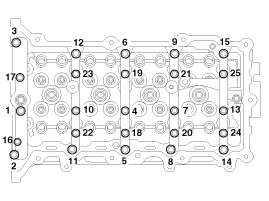
| • |
Be careful not to change the position and direction of bearing caps. |
|
|
| 6. |
Using a suitable tool, move the tensioner arm to align the tensioner bolt hole with the service hole. 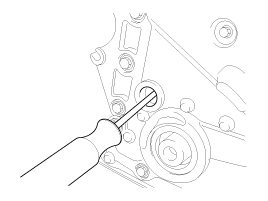
|
| 7. |
Install the tensioner arm bolt (A).
Tightening torque:
18.6 ~ 22.6 N.m (1.9 ~ 2.3 kgf.m, 13.7 ~ 16.6 lb-ft)
|

|
| 8. |
Remove the stopper pin from the tensioner. |
| 9. |
Turn the crankshaft two turns in the operating direction
(clockwise), and then check that the TDC marks of the CVVT sprockets are
in straight line on the cylinder head surface. 
|
| 10. |
Install a service plug bolt (A) with a gasket.
Tightening torque:
29.4 ~ 39.2 N.m (3.0 ~ 4.0 kgf.m, 21.7 ~ 28.9 lb-ft)
|

| • |
Do not reuse the service plug bolt and gasket. |
|
|
| 11. |
Install the intermediate lock CVVT actuator (A).
Tightening torque :
8.8 ~ 9.8 N.m (0.9 ~ 1.0 kgf.m, 6.5 ~ 7.2 lb-ft)
|

| • |
Always use new actuator bolts. |
| • |
The residue inside of the chain-cover bolt hole should be disposed before locking. |
| • |
The actuator bolts should be locked to the regulated torque. |
|
|
| 12. |
Install the other parts reverse order of removal. |
Description
Continuous Variable Valve Timing (CVVT) system advances or
retards the valve timing of the intake and exhaust valve in accordance
with the ECM control signal which is calculated by ...
Components
1. Camshaft bearing cap2. Camshaft front bearing cap3. Exhaust camshaft4. Intake camshaft5. Exhaust CVVT assembly6. Intake CVVT assembly7. Cam carrier8. Cylinder head9. Cylinder head g ...
 CVVT & Camshaft Description and Operation
CVVT & Camshaft Description and Operation Cylinder Head Components and Components Location
Cylinder Head Components and Components Location

























